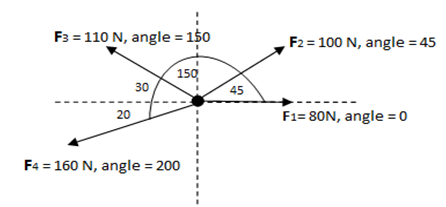Problem 5: Four coplanar forces act on a body at a point O as shown in figure. Find their resultant.

Solution
Strategy: Simply add the forces and get the resultant. The method should be adding by rectangular components. Find the x-components of all the forces and get the x-component of the resultant force by adding them up. Then find the y-components of all forces and sum up them to get the y-component of the resultant force. Once you have the x and y-components of the resultant force, use them to find the magnitude and direction of the resultant force.

Therefore,

Also

Therefore,

And

Therefore,

And

Therefore,

Add all the x-components to get the x-component of
the resultant. Hence adding (i), (iii), (v) and (vii) we have,
Fx = 80+70.7-95.26-150.24 = -94.8 N —–
(A)
Now add all the y-components to get the y-component
of the resultant force. Therefore, adding (ii), (iv), (vi) and (viii)
Fy = 0+70.7+55-54.4 = 71.3 N ——
(B)
Magnitude of the resultant
Magnitude of the resultant force is given by

|
Did you know? |
Put the values
from (A) and (B),

Direction of the Resultant
The direction of the resultant force can be
determined by

Put the values from (A) and (B)

As the x-component is negative and y-component is
positive, the resultant is in the second quadrant. So the angle for the
resultant force is

Equations (Y) and (Z) give the magnitude and
direction of the resultant force.

Pingback:numerical-problem-6-chapter-2-physics-11 – msa
Pingback:numerical-problem-4-chapter-2-physics-11-2 – msa
Pingback:Numerical on Vectors and Equilibrium, Physics 11 – msa